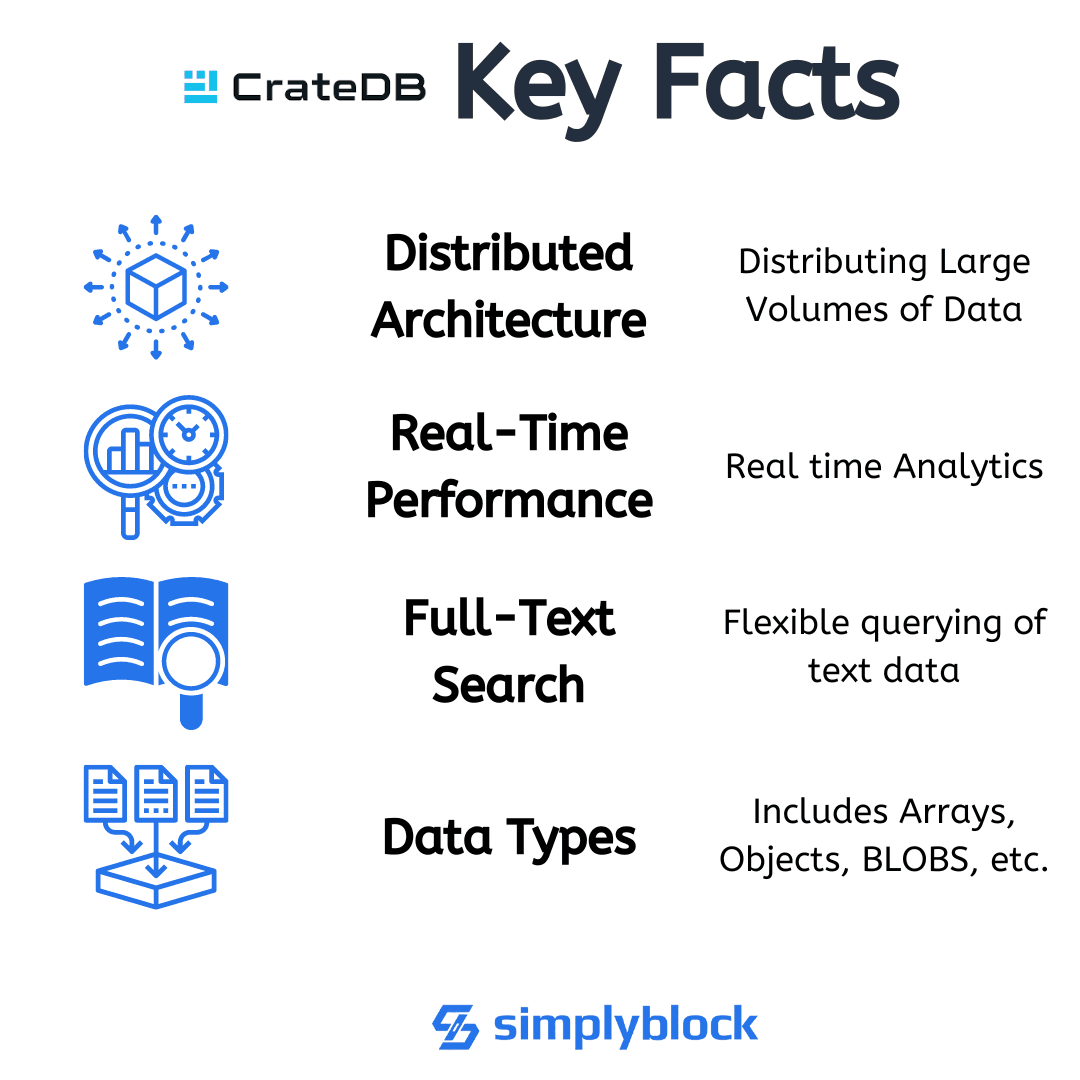CrateDB
Terms related to simplyblock
What is CrateDB?
CrateDB is an open-source, distributed SQL database built for real-time analytics on massive volumes of machine and time-series data. It is engineered for horizontal scalability and operational simplicity, offering the power of full-text search and standard SQL over semi-structured data. Built in Java and C++, CrateDB uses a PostgreSQL-compatible wire protocol, allowing easy integration with existing tools and applications.
Unlike traditional OLAP systems, CrateDB merges the performance of NoSQL with the familiarity of SQL. This makes it ideal for high-ingestion workloads such as logs, metrics, and sensor data coming from industrial systems, IoT networks, and enterprise telemetry pipelines.
CrateDB Architecture and Key Capabilities
CrateDB operates as a shared-nothing architecture. Data is sharded across multiple nodes, each storing a portion of the dataset and capable of executing queries in parallel. Its columnar storage engine, combined with Lucene for indexing, ensures high performance for both range and full-text queries.
CrateDB uses a distributed query planner that breaks SQL queries into fragments processed in parallel across the cluster. This enables low-latency aggregation and analytics at scale.
Key Technical Features
- SQL interface for structured, semi-structured, and unstructured data
- Distributed query execution with parallelism
- Native support for time-series queries
- Dynamic schema changes without downtime
- High ingestion throughput with bulk insert operations
- Full-text search capabilities via Apache Lucene
These capabilities are similar to what simplyblock™ offers in terms of high-performance data services across distributed systems—particularly for workloads that rely on consistent performance at scale.

CrateDB for Time-Series and Industrial Data
CrateDB is optimized for scenarios involving continuous data streams. For example, in IoT and IIoT (Industrial Internet of Things), it stores timestamped readings from thousands of devices and allows real-time dashboarding and alerting.
Its time-series capabilities include downsampling, retention policies, and out-of-order data handling, making it competitive with dedicated time-series databases like TimescaleDB.
In Kubernetes environments, persistent storage is critical for databases like CrateDB. Backends like simplyblock’s NVMe/TCP enhance database performance by lowering latency and maximizing IOPS.
CrateDB vs Traditional SQL Databases
CrateDB extends SQL for distributed systems. Compared to traditional relational databases, CrateDB offers scalability without needing sharding logic in the application layer. Here’s how it compares:
Comparison Table
| Feature | CrateDB | Traditional SQL (e.g., PostgreSQL) |
|---|---|---|
| Scalability | Horizontally scalable | Vertically scalable |
| Data Model | Semi-structured (JSON supported) | Strict relational |
| Query Language | SQL (ANSI + extensions) | SQL |
| Full-Text Search | Built-in via Lucene | Add-ons required |
| High Write Throughput | Optimized for time-series ingest | Not optimized for bulk ingest |
| Cluster Management | Built-in with discovery and failover | Often, external tooling is required |
Use Cases for CrateDB
CrateDB serves as a robust backend for operational analytics, predictive maintenance, and monitoring systems. Typical applications include:
- Industrial telemetry platforms
- Sensor and actuator data pipelines
- Application performance monitoring (APM)
- Business intelligence dashboards
- Network and log analytics
In cloud-native architectures, CrateDB benefits from persistent volumes, dynamic provisioning, and container-native replication strategies—especially when backed by disaggregated NVMe infrastructure such as that offered by simplyblock.
CrateDB in a Modern Storage Ecosystem
Although CrateDB handles distributed query planning internally, pairing it with a robust storage backend enables consistent performance at scale. Software-defined storage platforms like simplyblock enhance operational resilience, particularly in hybrid or edge deployments.
CrateDB instances deployed in Kubernetes environments gain from NVMe-based performance and can rely on multi-tenant support for secure data isolation.
Questions and Answers
CrateDB is a distributed SQL database designed for machine data, time-series analytics, and log processing. It combines the scalability of NoSQL with the simplicity of SQL, making it ideal for IoT, telemetry, and infrastructure monitoring. CrateDB fits well with database-on-Kubernetes deployments where real-time analytics are key.
Yes, CrateDB is optimized for time-series data with powerful indexing, native SQL support, and high ingest rates. It’s well-suited for use cases like sensor data, DevOps metrics, and industrial telemetry. Pairing CrateDB with high-performance NVMe storage ensures low-latency queries at scale.
CrateDB can be deployed on Kubernetes using StatefulSets. For persistent storage, it benefits from NVMe-over-TCP volumes provided by a CSI driver like Simplyblock, which offers high IOPS and automated volume encryption — perfect for scalable, stateful databases.
While both support SQL, CrateDB is distributed and built for horizontal scaling and real-time analytics. PostgreSQL excels in transactional workloads, but CrateDB is superior for time-series and machine data. It also integrates full-text search and dynamic schema features out of the box.
Yes, CrateDB supports flexible schema and isolation, making it a strong choice for SaaS platforms handling telemetry or analytics per customer. Combined with multi-tenant volume encryption, it can meet both performance and security needs.
